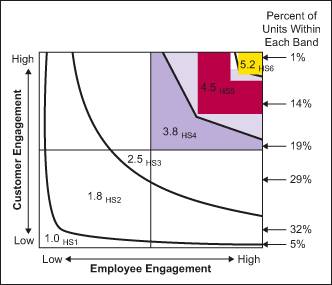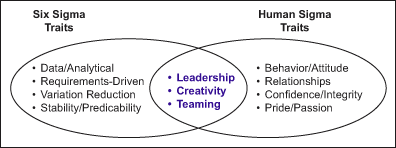
The most perfectly designed and built process or system is only as good as the human being who uses it. That’s the idea behind Human Sigma, a new branch of Six Sigma that focuses on improving the quality of the employee-customer encounter, particularly within sales and service organizations. Human Sigma proponents, including John H. Fleming and Jim Asplund, authors of Human Sigma: Managing the Employee-Customer Relationship (Gallup Press, 2007), argue that the traditional Six Sigma approach – while successful for controlling production processes and systems, particularly in the manufacturing environment – is just not suitable for the human systems that are a large part of organizational performance.
Six Sigma and Human Sigma are not mutually exclusive, however. In fact, when combined they can unleash a beneficial flywheel effect on leadership, creativity and teaming.
Defining Human Sigma
The Human Sigma management approach takes human nature into account and then uses that knowledge to manage and motivate employees, and accelerate their development, as well as to engage customers’ emotions. The central premise of Human Sigma is that emotionally satisfied customers contribute far more to the bottom line than rationally satisfied customers. The key is to strengthen the employee-customer interaction.
The approach relies on a simple yet powerful set of questions to measure customer engagement and employee engagement (Figures 1 and 2). Scores are ranked from 1 to 5, with 1 being not at all in agreement and 5 being extremely in agreement.
|
|||||
|
|||||
A company’s Human Sigma score is calculated by converting the mean scores on employee and customer engagement into percentile equivalents and then taking the square root of the product of the two percentile values. To account for certain boundary conditions, there is a correction value equal to the ratio of the two percentiles (highest over lowest) raised to the 0.125 power. This produces a single bimodally distributed score that is used to establish threshold values that define each of the Human Sigma levels: HS1 through HS6. The single score summarizes the overall effectiveness of the employee-customer encounter that is reliably related to that organization’s or business unit’s overall financial vitality.
Understanding the Human Sigma Levels
In 2007, Fleming and Asplund conducted a Human Sigma survey involving 1,979 business units in 10 different companies in the financial services, professional services, retail and sales industries. Their results are shown in Figure 3.

The HS3 threshold is defined as one standard deviation below HS4(meaning the standard deviation of the Human Sigma distribution). Successive thresholds are one standard deviation away from the adjacent level.
Organizations or business units at HS1 and HS2 perform significantly below par on employee or customer engagement metrics, and require significant intervention and improvement. Notice the long tails on these two performance bands. This extreme and unbalanced performance on the two metrics is associated with relatively poor financial performance. These two performance bands account for 37 percent of the companies studied. Organizations or business units at HS3 account for 29 percent of the companies studied and are also frequently out of balance, ranking high on one vital sign but poor on the other. Organizations or business units that engage their employees without engaging their customers suffer from being too inwardly focused and have lost their direction. In contrast, organizations or business units that engage their customers without engaging their employees cannot sustain themselves.
Organizations at HS4 are classified as “emerging optimized” performers. They have established balance in the vital signs of the employee-customer encounter, but there are still substantial gains to be made to strengthen these metrics. Organizations at HS5 and HS6 are classified as “super” performers. Overall, organizations in HS4, HS5 and HS6 are 3.4 times more effective financially than HS1, HS2 and HS3.
Introducing Variation
Most practitioners are familiar with the concept of variation and how to use a histogram to transform that variability into graphical form. Processes that are normally distributed exhibit the familiar symmetrical bell-shaped curve that has a single mode. The inherent problem with normally distributed processes, however, is that variability is largely unmanaged. The principles of Six Sigma instruct practitioners to attempt to manage this variability by shifting the process average and reducing process variation, because doing so helps to produce consistent and predictable processes. From a customer’s perspective, variability is critical because customers experience variation, not averages.
What makes Human Sigma intriguing and controversial is that it does not rely on reducing the variability in how employees are managed or how they serve customers. Human Sigma challenges conventional Six Sigma wisdom in that it strives to improve the quality of customer relationships by actually increasing the variability in how those relationships are developed and maintained.
Human Sigma contends that as an organization tries to standardize processes and scripts for management teams to follow, scripting employee behavior does not really enhance the quality of the employee-customer interaction. In fact, it may worsen it by emphasizing the steps to do the job instead of the outcome the process is supposed to produce. Human Sigma followers look at the manufacturing world and conclude companies can improve processes and systems because the inputs they use to make things can be kept at predictable and repeatable levels. But human systems in business – such as the employee-customer encounter – do not conform to such predictable rules. Sales and service organizations in particular, with a high degree of direct employee-customer interaction, cannot expect to follow such conforming practices as those in the manufacturing world.
Getting to the Core Principles
Fleming and Asplund have combined the key characteristics of employee engagement and customer engagement to produce four core principles that great organizations and managers exhibit:
- Manage by outcomes, not behaviors –In other words, although the end remains constant, the means to achieve that end will inevitably vary between individuals.
- Liberate, don’t legislate –The most dramatic increases in productivity occur when companies allow workgroups to choose their own initiatives and focus on them. Anything that makes employees passive viewers instead of active participants in the employee-customer encounter is counterproductive.
- Engagement is for everyone –The ability to capture the heads, hearts, and souls of employees and instill an intrinsic desire and passion for excellence.
- All politics is local – Companies cannot dictate employee engagement from corporate headquarters. They must manage engagement locally. To this end, the local manager is the single most important factor in local group performance.
Blending Six Sigma and Human Sigma
There are many opportunities to jointly apply the rigor of Six Sigma’s data-driven, analytical focus and Human Sigma’s behavioral and relationship traits to achieve even higher performance levels, regardless of the industry (service or manufacturing) or application (process, system or people). After all, at the center of Six Sigma or Human Sigma is a person – the customer.
Figure 4 shows the convergence of Six Sigma and Human Sigma and its positive impact on:
- Leadership –the strength to marshal the right resources, make the right decisions or go the extra mile when the situation demands it.
- Creativity –The wherewithal to think outside of the box, yet still operate effectively within the framework of an organization.
- Teaming – The ability to understand that successful outcomes often require teaming up with fellow employees and with customers.

Method-blending: See How It Works in Real Life
A few months ago, my father’s computer was not functioning properly. It seemed all the applications were operating extremely slowly. Over a three-day period, I had to call the vendor’s help desk eight times on behalf of my elderly father. Each call I was greeted by a polite technician and asked the same standard set of questions: Can I have your case number? Name? Call-back phone number? PC type? And so on.
During the first call the technician instructed me to perform a system restore to a previous date. I was advised to wait until the operation was completed and then reboot the machine. This did not work. I called the help desk twice more that day, and was given new troubleshooting tasks and told to call back if the issue remained. Neither solution worked. The next day, I called three more times, and agents asked me to perform a check disk scan, complete virus scan and an operating system reload. None of these worked either. I called the help desk again on the third day, and the technician was convinced I should perform a complete system recovery on the computer. This lasted several hours and still no luck.
By the eighth call, I was completely frustrated and exhausted. This particular agent immediately sensed my frustration. He also noted that this was my eighth call to the help desk in 72 hours. “Clearly, we have not solved your issue,” he said. Then he surprised me by asking a different set of questions:
- Agent: Who uses the computer?
- Peter: My father.
- Agent: What is his skill level operating it?
- Peter: My father is more of a novice.
- Agent: May I ask how old he is?
- Peter: Sure, he is 84 years old.
- Agent: What types of applications does he commonly use?
- Peter: Basically only email and word processing.
- Agent: Is an antivirus program loaded on the PC?
- Peter: Yes.
- Agent: OK, here’s what we’re going to do…
The agent took control of the PC remotely, and proceeded to remove or disable some unused programs to free up some RAM, cut back the application of the antivirus program, and delete unneeded files in the temp folder, all of which help the run faster.
This eighth agent solved my father’s slow PC. While the previous seven agents flawlessly executed the carefully scripted troubleshooting steps, they failed to grasp the importance of the outcome the process was supposed to produce. Most of their emphasis was on how to do the job instead of the outcomes that would result if the job was well done. The eighth agent not only followed the script, but also – sensing the special situation – applied his own personal experience with a set of probing questions and a self-help approach. He combined the best of Six Sigma and Human Sigma to produce the desired outcome: a satisfied customer. In the process he initiated his own personalized form of leadership, creativity and customer relations.